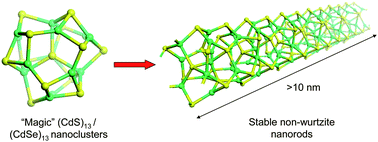Persistence of magic cluster stability in ultra-thin semiconductor nanorods
Abstract
The progression from quasi zero-dimensional (Q0D) nanoclusters to quasi one-dimensional (Q1D)

* Corresponding authors
a Departament de Química Física & Institut de Química Teòrica i Computacional (IQTCUB), Universitat de Barcelona, C/Martí i Franquès 1, E-08028 Barcelona, Spain
b Department of Chemistry, Kasetsart University, Bangkok 10900, Thailand
c Center of Nanotechnology, Kasetsart University, Bangkok 10900, Thailand
d NANOTEC Center of Excellence, National Nanotechnology Center, Kasetsart University, Bangkok 10900, Thailand
e Institució Catalana de Recerca i Estudis Avançats (ICREA), 08010 Barcelona, Spain
The progression from quasi zero-dimensional (Q0D) nanoclusters to quasi one-dimensional (Q1D)

 Please wait while we load your content...
Something went wrong. Try again?
Please wait while we load your content...
Something went wrong. Try again?
W. Sangthong, J. Limtrakul, F. Illas and S. T. Bromley, Nanoscale, 2010, 2, 72 DOI: 10.1039/B9NR00282K
To request permission to reproduce material from this article, please go to the Copyright Clearance Center request page.
If you are an author contributing to an RSC publication, you do not need to request permission provided correct acknowledgement is given.
If you are the author of this article, you do not need to request permission to reproduce figures and diagrams provided correct acknowledgement is given. If you want to reproduce the whole article in a third-party publication (excluding your thesis/dissertation for which permission is not required) please go to the Copyright Clearance Center request page.
Read more about how to correctly acknowledge RSC content.
 Fetching data from CrossRef.
Fetching data from CrossRef.
This may take some time to load.
Loading related content
